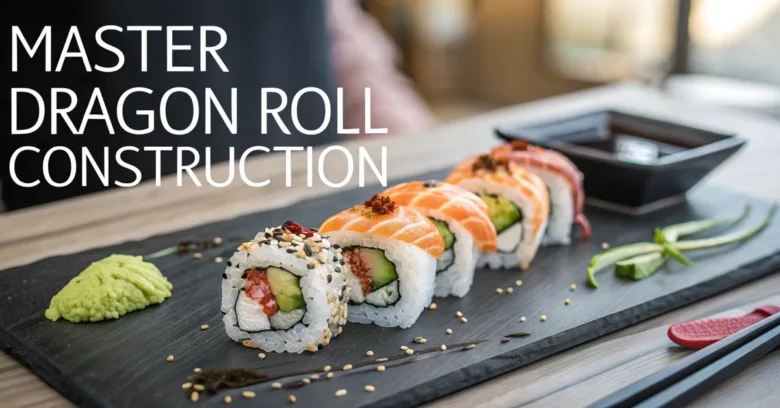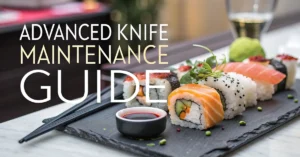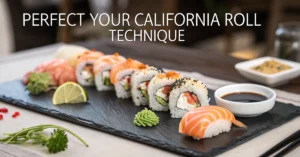Dragon roll construction might seem like an art best left to sushi chefs. Yet, think of this: those rolls, those masterful arrangements, are the product of careful technique and learned skill, not magic. You, too, can build your own breathtaking dragon roll. It just takes know-how and a bit of practice.
This guide is crafted for the home sushi maker who’s looking to graduate beyond the basics. We’ll break down the entire process, from the perfect rice to the final drizzle of eel sauce. Think of it as your advanced course in dragon roll artistry. No smoke and mirrors, just clear instruction to help you build something amazing.
Essential Ingredients for a Superior Dragon Roll
A proper dragon roll is more than just the sum of its parts. The quality of your ingredients will make or break the final result.
The Foundation: Sushi Rice
Sushi rice is the cornerstone of any good roll, and dragon rolls are no different. Use short-grain Japanese rice, sometimes labeled “sushi rice.” The ideal texture is slightly sticky, allowing the roll to hold its shape without being mushy.
How to cook it right:
- Rinse: Rinse the raw rice under cold water until the water runs clear. This removes excess starch.
- Cook: Use a rice cooker or pot. If using a pot, the ratio is generally 1 part rice to 1.2 parts water.
- Steam: Let the cooked rice steam, covered, for about 10 minutes.
- Season: Gently mix in sushi vinegar (a mix of rice vinegar, sugar, and salt) while the rice is still warm. The ratio is usually around 2 tablespoons of sushi vinegar per cup of cooked rice.
The Core: Fillings that Complement
While a dragon roll can be quite versatile in its filling, here are some tried-and-true options that offer a balanced flavor profile:
- Imitation Crab (Krab): This is a common and cost-effective choice, adding a subtly sweet and savory element.
- Cucumber: Provides a refreshing crunch and helps to balance the richness of other ingredients.
- Avocado: Contributes a creamy texture and mild flavor, blending seamlessly with the other components.
These fillings are often combined, creating a cohesive core that contrasts nicely with the exterior elements of the roll.
The Dragon’s Scales: Avocado Artistry
The “scales” of a dragon roll are thinly sliced avocado, artfully arranged over the top of the roll. This is where your visual finesse comes into play. Look for avocados that are ripe but firm—they should yield slightly to pressure but not be mushy.
The Garnish: A Finishing Touch
The final touches elevate the dragon roll from simply tasty to visually stunning:
- Eel Sauce (Unagi Sauce): A sweet and savory sauce, usually drizzled over the top of the avocado scales.
- Sesame Seeds: Add a nutty flavor and subtle crunch, contrasting with the soft texture of the avocado.
- Spicy Mayo (Optional): For those who enjoy a bit of heat, a drizzle of spicy mayo can add a welcome kick.
Other Considerations
- Nori (Seaweed): You will need sushi-grade nori sheets. These are dried seaweed sheets that act as the wrapper for the inner roll.
- Bamboo Rolling Mat: This is a vital tool for shaping the roll. Make sure to cover it in plastic wrap to prevent sticking.
- Sharp Knife: A sharp knife is essential for clean cuts.
Tools of the Trade: Equipping Your Sushi Kitchen
Beyond the ingredients themselves, having the right tools will significantly impact the ease and success of your dragon roll construction.
The Indispensable Bamboo Rolling Mat
This is the foundation upon which your rolls will take shape. The bamboo mat provides the necessary structure to compress and form the roll. To prevent sticking, wrap it tightly in plastic wrap before each use.
The Razor-Sharp Sushi Knife
A dull knife will tear the nori and fillings, leading to a messy presentation. Invest in a good-quality sushi knife (or a very sharp chef’s knife) and keep it honed. Wet the blade between cuts for cleaner slices.
The Trusty Rice Cooker
While not strictly essential, a rice cooker makes the process of cooking sushi rice infinitely easier and more consistent. It ensures perfectly cooked rice every time, which is crucial for a successful roll.
Small Bowls of Water
Keep a small bowl of water nearby. Dip your fingers in it to prevent the rice from sticking to your hands while spreading it on the nori.
Mastering the Art of Avocado Slicing and Arrangement
The avocado scales are arguably the most visually striking part of a dragon roll. Mastering this technique will set your rolls apart.
Selecting the Perfect Avocado
- Ripeness: Choose avocados that are ripe but firm. They should yield slightly to pressure but not be mushy.
- Color: The skin should be a dark green, almost black.
- Stem Test: Pluck off the small stem at the top of the avocado. If it’s green underneath, the avocado is ripe. If it’s brown, it’s overripe.
The Slicing Technique
- Halve the Avocado: Cut the avocado lengthwise around the pit. Twist the two halves to separate them.
- Remove the Pit: Carefully whack the pit with the blade of your knife (be careful!). Twist the knife to remove the pit. Alternatively, use a spoon to scoop out the pit.
- Slice Thinly: With the avocado half facing down on your cutting board, slice it thinly lengthwise. Aim for even slices about 1/8 inch thick.
- Gently Fan: Gently fan out the slices, keeping them connected at the base. This makes it easier to transfer them to the roll.
Arranging the Scales
- Transfer Carefully: Carefully lift the fanned avocado slices and transfer them to the top of the prepared roll.
- Shape the Dragon: Gently shape the avocado slices to resemble dragon scales. You can slightly overlap them to create a more pronounced effect.
- Secure the Scales: Use the bamboo rolling mat to gently press the avocado scales onto the roll, ensuring they adhere firmly.
Step-by-Step Dragon Roll Construction: The Advanced Guide
Now, let’s put all the elements together. Here’s a detailed, step-by-step guide to building your own magnificent dragon roll.
Step 1: Preparing the Nori and Rice
- Place Nori: Place a sheet of nori on the bamboo rolling mat, shiny side down.
- Spread Rice: Evenly spread a thin layer of sushi rice over the nori, leaving about an inch of space at the top edge. This space will help seal the roll.
- Compress Rice: Gently press the rice onto the nori, ensuring it adheres well.
Step 2: The Inversion Technique
This is what sets the dragon roll apart from a standard roll.
- Flip the Nori: Carefully flip the nori sheet over so that the rice is facing down on the bamboo mat. The nori should now be facing up.
Step 3: Adding the Fillings
- Arrange Fillings: Place your chosen fillings (imitation crab, cucumber, avocado) horizontally across the center of the nori sheet. Don’t overfill, as this will make it difficult to roll.
Step 4: Rolling the Roll
- Lift and Tuck: Lift the edge of the bamboo mat closest to you and tuck it over the fillings.
- Roll Firmly: Roll the mat forward, applying gentle pressure to create a tight, compact roll.
- Seal the Roll: Once you reach the end of the nori sheet, moisten the bare edge with a little water to seal the roll.
Step 5: Applying the Avocado Scales
- Prepare Avocado: As detailed above, slice the avocado thinly and arrange it into a fan shape.
- Transfer to Roll: Carefully transfer the fanned avocado slices to the top of the roll.
- Shape the Scales: Gently shape the avocado slices to resemble dragon scales, slightly overlapping them for a more pronounced effect.
- Secure with Mat: Use the bamboo rolling mat to gently press the avocado scales onto the roll, ensuring they adhere firmly.
Step 6: Cutting and Plating
- Wet the Knife: Wet your sharp knife with water.
- Cut in Half: Cut the roll in half.
- Cut into Pieces: Cut each half into 4-6 equal pieces.
- Plate Artfully: Arrange the pieces artfully on a plate.
Step 7: Garnishing
- Drizzle Eel Sauce: Drizzle eel sauce (unagi sauce) over the top of the avocado scales.
- Sprinkle Sesame Seeds: Sprinkle sesame seeds over the roll.
- Add Spicy Mayo (Optional): Drizzle spicy mayo over the roll for added flavor.
Common Pitfalls and How to Avoid Them
Even with the best instructions, mistakes can happen. Here’s a guide to common problems and their solutions.
Rice is Too Mushy
- Problem: The rice is overcooked or has too much water.
- Solution: Reduce the amount of water used when cooking the rice. Ensure you rinse the rice thoroughly before cooking to remove excess starch.
Rice is Too Hard
- Problem: The rice is undercooked or doesn’t have enough water.
- Solution: Increase the amount of water used when cooking the rice. Ensure you let the rice steam, covered, for the recommended time after cooking.
Roll Falls Apart
- Problem: The roll isn’t rolled tightly enough, or the rice isn’t sticky enough.
- Solution: Apply more pressure when rolling the roll. Ensure you use sushi rice and season it properly with sushi vinegar.
Avocado Scales Slide Off
- Problem: The avocado is too ripe, or the scales aren’t secured properly.
- Solution: Use avocados that are ripe but firm. Ensure you gently press the avocado scales onto the roll with the bamboo rolling mat.
Knife Tears the Nori
- Problem: The knife is dull.
- Solution: Use a very sharp knife. Wet the blade between cuts for cleaner slices.
Flavor Variations: Beyond the Traditional Dragon
Once you’ve mastered the basic dragon roll, don’t be afraid to experiment with different flavor combinations. Here are a few ideas to get you started:
Spicy Tuna Dragon
- Filling: Spicy tuna mix (tuna, spicy mayo, sriracha), cucumber
- Garnish: Eel sauce, sesame seeds, sriracha
California Dragon
- Filling: Imitation crab, avocado, cucumber
- Garnish: Eel sauce, sesame seeds, tobiko (flying fish roe)
Vegetarian Dragon
- Filling: Tofu, cucumber, avocado, pickled radish
- Garnish: Eel sauce (check for vegetarian options), sesame seeds
Shrimp Tempura Dragon
- Filling: Shrimp tempura, cucumber, avocado
- Garnish: Eel sauce, sesame seeds, tempura flakes
Plating and Presentation: Elevating the Experience
The presentation of your dragon roll is just as important as the taste. Here are some tips for creating a visually stunning plate:
Strategic Arrangement
- Angle: Arrange the sushi pieces at a slight angle for a more dynamic look.
- Height: Create some height by layering pieces slightly.
Sauce Placement
- Drizzle Artfully: Drizzle the eel sauce and spicy mayo in a zigzag pattern.
- Avoid Over-Saucing: Use a light hand to avoid overpowering the other flavors.
Garnish Placement
- Sprinkle Evenly: Sprinkle sesame seeds evenly over the roll.
- Consider Color: Use contrasting garnishes, such as green onions or red pepper flakes, for a pop of color.
Add Visual Elements
- Edible Flowers: Add edible flowers for a touch of elegance.
- Pickled Ginger: Include a small mound of pickled ginger (gari) for palate cleansing.
- Wasabi: Add a small dollop of wasabi for those who enjoy the heat.
The Final Verdict: Is the Dragon Roll Worth the Effort?
The dragon roll, with its intricate construction and striking visual appeal, might seem daunting. But with the right preparation and a bit of practice, it’s an achievable and incredibly rewarding culinary project. This guide has walked you through every step, from selecting the freshest ingredients to mastering the art of avocado scales. It’s not just about making sushi; it’s about crafting an experience. So gather your ingredients, sharpen your knives, and unleash your inner sushi artist. The result is a dish that’s as delicious as it is impressive – a true testament to your sushi-making skills.



